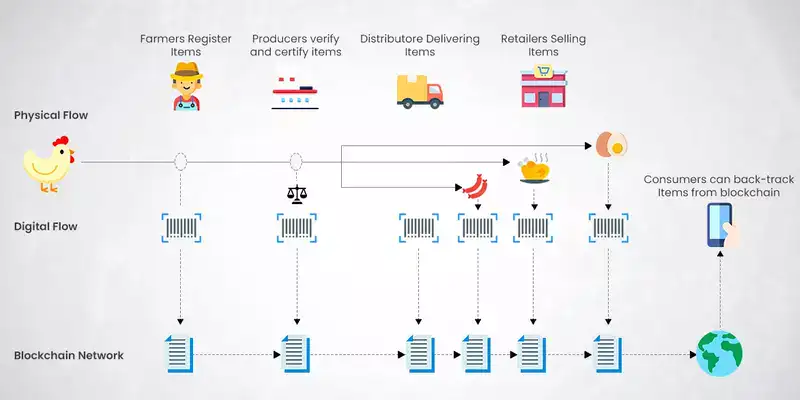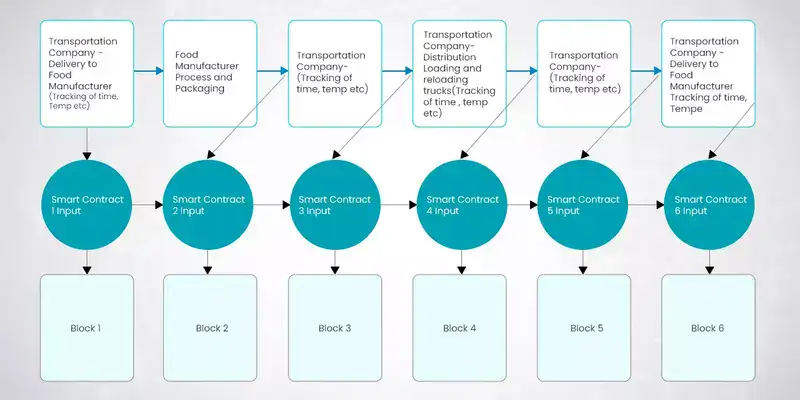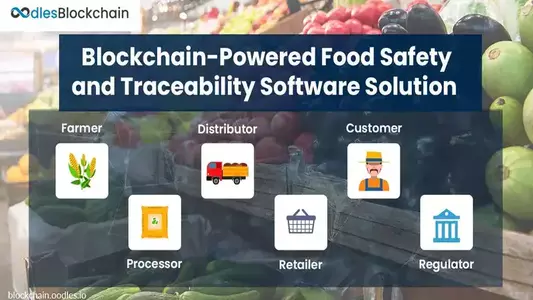-
Can blockchain solutions for the food supply chain provide end-to-end traceability? Indeed, it can. Initially, it was a technology used to transform the financial sector and crypto-currencies. However, due to its potential to simplify the access to accurate data about the sources, manufacturing conditions, and delivery of a product through the supply chain, companies are extensively exploring its applications.
Our food system comprises one of the world's most dynamic and fractured supply chains. Businesses are exploring blockchain to achieve the capability to track and guarantee the provenance of a food product while also tracing its manufacturing conditions. They believe that a blockchain-based supply chain system for food traceability can be the most viable solution. It can enable them to achieve trustless traceability and transparency across the food supply chain.
Why is Food Traceability the Need of the Hour
The food supply chain may comprise an average of 10-15 intermediaries that are interdependent but often have low confidence in each other. It makes it hard for retailers and wholesalers to identify the origin of a manufactured and shipped product and track its end-to-end movement. Further, fragmented channels of communication usually occur between two actors at a time and in only one supply chain path. Also, the slow process of digitization and time-consuming administration impedes efficient communication.
Disparate data systems ensuring ineffective transparency in the supply chain minimizes corporations' ability to influence progress, not only in manufacturing processes but also in fraud prevention. On top of this, the necessary data never reaches a user.
It is not easy to improve accountability in the food supply chain. It needs all players in the supply chain to have the will and cooperation.
Unfortunately, disputes are common, while solutions are expensive. Ensuring that requirements meet demands, requires following up with vendors. It is a time-consuming process due to collaboration being uncommon.
Also, Read | Strengthening Food Supply Chain with Blockchain Amid COVID-19
Can Blockchain be the Right Technology for the Solution
Blockchain is a distributed digital ledger-based network that can act as a decentralized food industry database. Its infrastructure enables blockchain-connected actors to access all data exchanged by all actors in the chain in real-time. This technology can also enhance the requisite trust between actors. Without network consensus, nobody can manipulate or retroactively alter the submitted data to the blockchain. Essentially, blockchain can make food safety, control of origin, and traceability processes dramatically simpler. Take a look at the following diagram to understand how products may move across the supply chain, with traceability and transparency.

Traceability System Based on Blockchain and Internet of Things
Blockchain has tremendous potential in the food industry when combined with the new data-capture technologies. Based on its strengths and the Internet of Things ( IoT), it can revolutionize the food industry. IoT technologies, connecting the physical and digital worlds, can capture data such as temperature and humidity during product shipping or storage. Further, blockchain can provide a network-wide, secure, and permanent database in which every participant in the supply chain can store and access data.
The following can be the benefits of the integration of blockchain technology with IoT sensors and trackers provide:
- Streamlined supply chain and reduced costs for retailers
- More clear compliance with regulations
- Strengthened and fast food recall cycle
- End-to-end transparency
- Real-time traceability
Blockchain could radically change the food supply chain as per the United Nations Food and Agriculture Organization (FAO) policy paper for 2018. According to the policy paper, blockchain technology will facilitate the creation of a transparent supply chain contract between different disconnected parties, enabling end-to-end transparency throughout the system.
In the supply chain network, a smart contract solution can come in use to reduce the number of intermediaries. As an alternative, a smart contract can significantly reduce transaction costs, increase margins, and boost productivity. Thus, it can lead to a large chunk of income going to the farmer/producer. Here's a diagram of how the system would work.

Several IT giants have made various blockchain systems or solutions for the food industry. A few instances are IBM's Food Trust and Watson platforms, Track and Trace platform, and SAP's Leonardo platforms, Track and Trace platform, and Oracle's Internet of Things solutions.
Also, Read | Developing a Food Delivery App with Blockchain
A Use Case | PoC
In October 2016, Walmart launched two ventures with its technology partner IBM. One was for tracking the source of mangoes sold in Walmart's US stores. Another was aiming at tracking pork sold in their China stores.
A team bought a package of sliced mangoes at a nearby Walmart store for the mango POC. Then, it began determining from which farm they had come – as quickly as possible. It contacted and emailed manufacturers and suppliers and finally got a response nearly seven days later.
As per industry standards, it wasn't bad. However, Walmart has planned to do something better. Thus, they had worked together with IBM to develop a blockchain-based food traceability network.
To develop the program, the Walmart Development team referred to their processes as well as those of their suppliers.
Archana Sristy, Walmart's Director of Engineering, states that their team co-managed the core design and implementation configuration with IBM, as well as developed integration with the enterprise systems. They collaborated with GS1 to identify the data attributes for uploading to the blockchain (the authority of barcodes and labeling). IBM wrote the Chaincode. Suppliers used new labels and used a web-based interface to upload their results.
The food traceability framework, based on Hyperledger Fabric blockchain, showed significant results for these PoCs. For pork in China, it enabled vendors to submit authenticity certificates to a blockchain database, adding more trust to a system. The time it took for mangoes in the US to trace their provenance went from 7 days to nearly 2.2 seconds!
Also, Read | Modernizing Food Supply Chain with Blockchain | From Farm to Table
Using a Blockchain Platform for Development
Walmart considered several innovations for a blockchain platform but eventually opted for one of the Hyperledger projects for blockchain app development, Fabric.
It fulfills all the requirements of a food traceability network based on blockchain technology. It is a permissioned blockchain technology of enterprise standards.
Working with an open-source, vendor-neutral blockchain was also necessary. Because several people, including Walmart's suppliers and even direct rivals, wanted to use the food traceability program, the technology ecosystem underlying has to be open in a permissioned way.
Hyperledger Fabric is a blockchain operating system, one of The Linux Foundation hosted projects. Intended as a framework for the creation of applications or implementations with a modular architecture, Hyperledger Fabric allows plug-and-play modules, such as consensus and membership services. Hyperledger Fabric leverages container technology to host "chaincode" smart contracts that constitute the system's application logic.
Also, Read | A Use Case for Blockchain in Thorium's Supply Chain Traceability
Conclusion
Blockchain is a revolutionary multidimensional-benefit technology. When used with IoT, it can create a transparent, traceable food supply chain, reduce food theft, and build consumer confidence.
Our blockchain experts think that we need to bring this technology to the forefront of the packaged food world. However, for that, food producers, participants in the supply chain, government agencies, and information technology experts need to work together. They need to develop a systematic roadmap for applying Blockchain technologies in the food industry.
Comments To “Blockchain-based Food Supply Chain Traceability System”

Our Offices
INDIA
Emaar Digital Greens, Sector 61,
Gurugram, Haryana
122011.
Welldone Tech Park,
Sector 48, Sohna road,
Gurugram, Haryana
122018.














March 1, 2021 at 2:44 pm
again